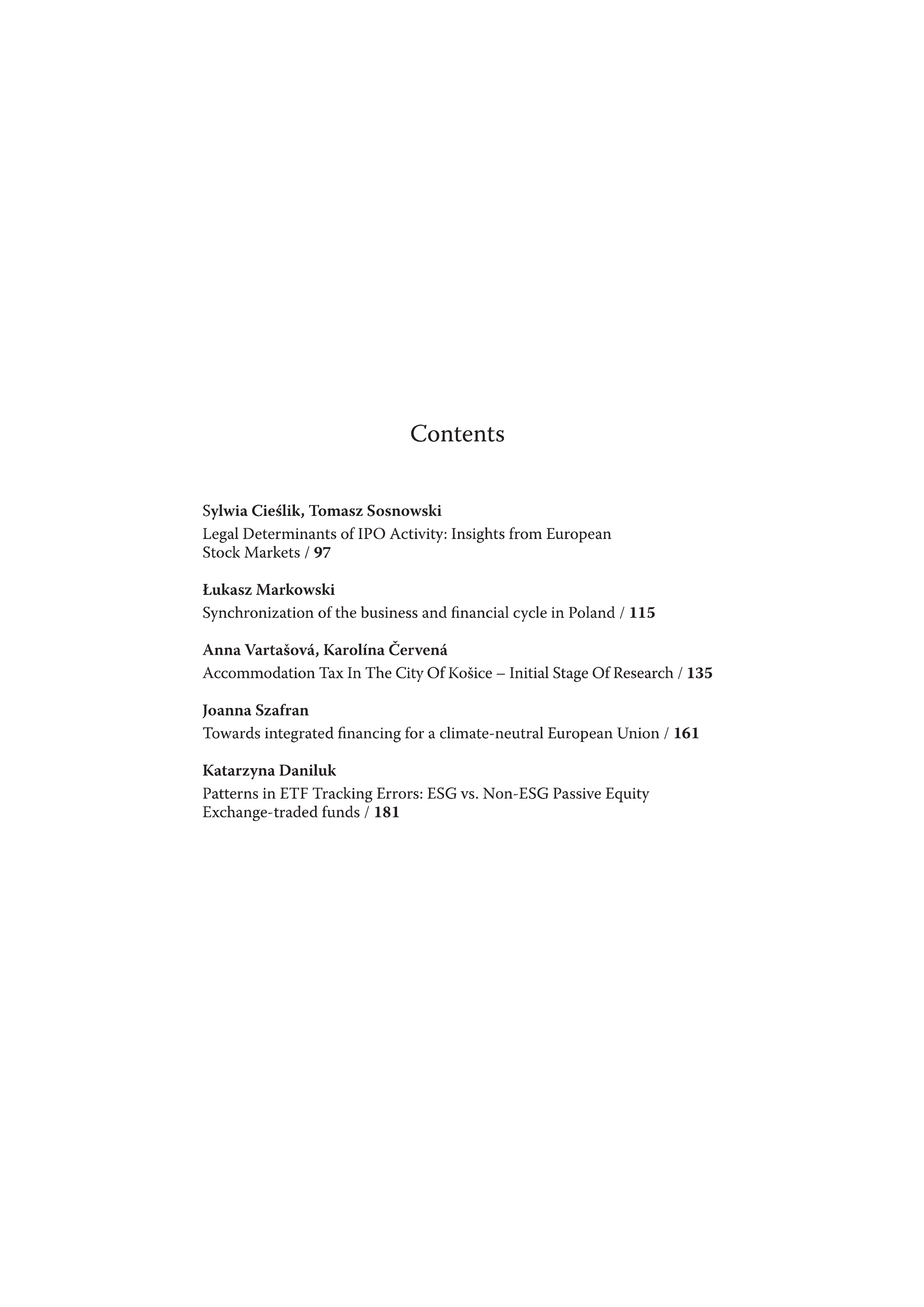Patterns in ETF Tracking Errors: ESG vs. Non-ESG Passive Equity Exchange-traded funds
DOI:
https://doi.org/10.12775/EiP.2025.10Keywords
Exchange-Traded Funds, ESG Investing, Tracking Error, Passive InvestmentAbstract
Motivation: Passive exchange-traded funds (ETFs) are designed to replicate index performance but face tracking errors due to costs and market inefficiencies. ESG ETFs, which incorporate environmental, social, and governance factors, have become increasingly popular in Europe. However, limited research has examined their tracking errors patterns in comparison to non-ESG ETFs.
Aim: This study is among the first to systematically assess the determinants of tracking error in passive ESG equity ETFs listed on European exchanges and compares them to non-ESG counterparts. Employing dynamic panel GMM models, we investigate key factors influencing tracking error, including past tracking error, total expense ratio (TER), assets under management (AUM), benchmark volatility, and fund age.
Results: Analysing 48 ESG and 86 non-ESG equity ETFs from January 2021 to June 2024, we find that past tracking error, total expense ratio, and benchmark volatility significantly impact tracking error for both fund categories. Assets under management significantly affects tracking error only in ESG ETFs. Fund age has no significant impact in either group. These findings suggest that cost control and risk management are crucial for minimizing tracking error in both fund categories, while economies of scale play a more significant role in ESG ETFs.
References
Agapova, A. (2011). Conventional mutual index funds versus exchange-traded funds. Journal of Financial Markets, 14(2), 323–343. https://doi.org/10.1016/j.finmar.2010.10.005.
Blitz, D., Huij, J., & Swinkels, L. (2012). The performance of European index funds and exchange‐traded funds: European index funds and exchange-traded funds. European Financial Management, 18(4), 649–662. https://doi.org/10.1111/j.1468-036x.2010.00550.x.
Charupat, N., & Miu, P. (2013). The pricing efficiency of leveraged exchange-traded funds: Evidence from the u.S. Markets: Pricing efficiency of leveraged exchange-traded funds. Journal of Financial Research, 36(2), 253–278. https://doi.org/10.1111/j.1475-6803.2013.12010.x.
Chu, P. K.-K. (2011). Study on the tracking errors and their determinants: evidence from Hong Kong exchange traded funds. Applied Financial Economics, 21(5), 309–315. https://doi.org/10.1080/09603107.2010.530215.
ETFGI. (2024). ETFGI Reports Assets of 530.64 Billion US Dollars Invested in ESG ETFs Listed Globally. Retrieved February 3, 2025 from https://etfgi.com/news/press-releases/2024/03/etfgi-reports-assets-53064-billion-us-dollars-invested-esg-etfs-listed#:~:text=At%20the%20end%20of%20February%202024%2C%20ESG%20ETFs,providers%20listed%20on%2046%20exchanges%20in%2036%20countries.
DeFusco, R. A., Ivanov, S. I., & Karels, G. V. (2011). The exchange traded funds’ pricing deviation: analysis and forecasts. Journal of Economics and Finance, 35(2), 181–197. https://doi.org/10.1007/s12197-009-9090-6.
Drenovak, M., Urošević, B., & Jelic, R. (2014). European bond ETFs: Tracking errors and the sovereign debt crisis. European Financial Management, 20(5), 958–994. https://doi.org/10.1111/j.1468-036X.2012.00649.x
Elia, M. (2012). Tracking error of traditional and synthetic European exchange-traded funds. SSRN Electronic Journal. https://doi.org/10.2139/ssrn.2084929.
Elton, E. J., Gruber, M. J., Comer, G., & Li, K. (2002). Spiders: Where are the bugs? The Journal of Business, 75(3), 453–472. https://doi.org/10.1086/339891.
Frino, A., & Gallagher, D. R. (2001). Tracking S&P 500 index funds. The Journal of Portfolio Management, 28(1), 44–55. https://doi.org/10.3905/jpm.2001.319822.
Gallagher, D. R., & Segara, R. (2006). The Performance and Trading Characteristics of Exchange-Traded Funds. Journal of Investment Strategy, 1(1), 47–58.
Ivanov, S. I. (2015a). An empirical examination of currency ETFs tracking error. International Journal of Bonds and Derivatives, 1(4), 333. https://doi.org/10.1504/ijbd.2015.073794.
Ivanov, S. I. (2015b). Intraday analysis of currency ETFs. International Journal of Managerial Finance, 11(4), 438–450. https://doi.org/10.1108/ijmf-10-2014-0161.
Johnson, B., Bioy, H., Kellett, A., & Davidson, L. (2013). On the right track: measuring tracking efficiency in ETFs. The Journal of Index Investing, 4(3), 35–41. https://doi.org/10.3905/jii.2013.4.3.035.
Khan, A., Bacha, O., & Masih, A. M. (2015). Performance and trading characteristics of exchange Traded Funds: Developed vs emerging markets. Capital Markets Review, 23(1 & 2), 40–64. https://econpapers.repec.org/article/mfajournl/v_3a23_3ay_3a2015_3ai_3a1&2_3ap_3a40-64.htm.
Lee, S.-W. (2020). Performance of ESG ETF by price disparate ratio and tracking error. Korea Association of Business Education, 35(6), 309–329. https://doi.org/10.23839/kabe.2020.35.6.309.
Lin, A., & Chou, A.-T. (2006). The tracking error and premium/ discount of Taiwan’s first exchange traded fund. Retrieved February 3, 2025 from https://www.semanticscholar.org/paper/ac5bd87cb7d4f2ac6740373998dcb1efe78f6a5b.
Morningstar. (2025). European ETFs Attract Record Inflows in 2024. Retrieved February 3, 2025 from https://www.morningstar.co.uk/uk/news/259560/european-etfs-attract-record-inflows-in-2024-.aspx.
Morningstar. (2025). European ETFs Attract Record Inflows in 2024. Retrieved February 3, 2025 from https://www.morningstar.co.uk/uk/news/259560/european-etfs-attract-record-inflows-in-2024-.aspx.
Miziołek, T., & Feder-Sempach, E. (2019). Tracking ability of exchange-traded funds. Evidence from Emerging Markets Equity ETFs. Bank i Kredyt, 50(3), 221–248.
Nguyen, H. (2023). COVID-19: PERFORMANCE OF ESG ETFS AND, ESG ETFS VS. THEIR DECLARED INDEXES. Applied Finance Letters, 12(1), 33–43. https://doi.org/10.24135/afl.v12i1.647.
Osterhoff, F., & Kaserer, C. (2016). Determinants of tracking error in German ETFs – the role of market liquidity. Managerial Finance, 42(5), 417–437. https://doi.org/10.1108/mf-04-2015-0105.
Poterba, J. M., & Shoven, J. B. (2002). Exchange-traded funds: A new investment option for taxable investors. American Economic Review, 92(2), 422–427. https://doi.org/10.1257/000282802320191732.
Qadan, M., & Yagil, J. (2012). On the dynamics of tracking indices by exchange traded funds in the presence of high volatility. Managerial Finance, 38(9), 804–832. https://doi.org/10.1108/03074351211248162.
Roll, R. (1992). A mean/variance analysis of tracking error. The Journal of Portfolio Management, 18(4), 13–22. https://doi.org/10.3905/jpm.1992.701922.
Rompotis, G. G. (2011). Predictable Patterns in ETF’s Return and Tracking Error. Studies in Economics and Finance, 28(1), 14–35.
Rompotis, Gerasimos G. (2009). Interfamily competition on index tracking: The case of the vanguard ETFs and index funds. Journal of Asset Management, 10(4), 263–278. https://doi.org/10.1057/jam.2009.11.
Downloads
Published
How to Cite
Issue
Section
License
Copyright (c) 2025 Katarzyna Daniluk

This work is licensed under a Creative Commons Attribution-NoDerivatives 4.0 International License.
Stats
Number of views and downloads: 3
Number of citations: 0
